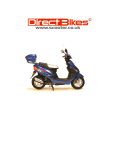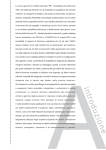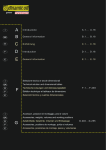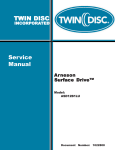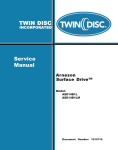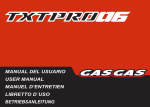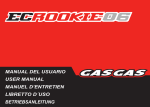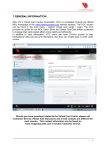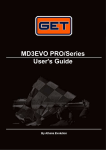Download Direct Bikes DB50QT-A Specifications
Transcript
Manual-DB50QT-A Dear Customer: Thank you for purchasing the Direct Bikes DB50QT-A scooter. The Direct Bikes DB50QT-A scooter is manufactured using some of the most advanced production techniques in the world. The scooter features high performance, economic fuel consumption and low noise levels. This manual provides detailed information about the correct operation, maintenance and adjustment of your DB50QT-A scooter. Please read this manual carefully to ensure safety and maximum ease of use. 1 Important Notice: • Driver and passenger This vehicle is designed to carry only one driver and one passenger. The driver is required to have the appropriate licence for these requirements. Do not exceed the rated load capacity specified on the specification label. • Road condition This vehicle is designed to travel on flat roads. Do not ride this vehicle in freezing or hazardous conditions. • Modifications This vehicle should not be modified. CAUTION: Personal injury or mechanical damage may result if you fail to operate as instructed in the manual. 2 Location of Component parts (1) Back-view mirror (4) Muffler (2) Headlight (5) Taillight (3) Front turn signal light (6) Seat 3 Meter Panel and Indicators All the controls for the indicators and warning lights are located on the meter panel. (1) Speedometer (2) Mileometer (3) High beam indicator (4) Turn right signal light (5) Turn left signal light (6) Fuel meter Fuel gauge The fuel gauge indicates the approximate amount of fuel remaining in the fuel tank. When the needle pointer stays in the F(full) position, it means the total capacity of the fuel tank is now 6.0 litres (including reserve fuel). When the needle pointer approaches the first dot on the red mark, it means that the fuel tank must be refilled immediately. 4 Identification The VIN or chassis number is located on the frame of the scooter and is either under the seat or under the clip in cover in the front of the foot well. The engine number is located on the left side on the bottom of engine. NOTE: You should regard this manual as a permanent component part of your vehicle, it is essential for the continued operation and safety of your scooter to perform periodic servicing by an approved dealer. This is required under your warranty. 5 Fitting the accessories Mirrors The mirrors come ‘handed’, i.e. a left and right one. They screw into either the left and right switch gear or into the front and back brake lever assemblies. There is a lock nut on the threaded part of the mirror to ensure the mirror does not come loose. Wind this lock nut up as far as it will go and carefully screw the mirror into the mount. It is important you do not ‘cross thread’ the mirror as it will damage the mount. When the mirror is in as far as it will go sit on the motorcycle and make sure you can see behind you. Once done move the lock nut down and tighten being careful not to over tighten. Finish by sliding the rubber boot down over the lock nut. 6 Top box 1. Check the accessories. 2. Put the plastic bottom-board centrally on the rear bracket, notice the four holes highlighted in photo with white circles. 7 3. Put the top box centrally on the plastic bottom-board, notice the four holes inside the top box highlighted in photo with white circles. 4. With these four holes (highlighted in white circles in figure 3) insert the 4 bolts and 4 washers. 8 5. Insert the bolts through the four aligned holes in the bottom-board (highlighted in white circles in figure 2). Hold the long slotted bars under the rack with the edges of the bars facing upwards. Put the bolts through the holes of the slotted bars. 6. Attach nuts to the bolts nearest the tail of the scooter. With the further bolts attach the rubber buffers in between the slotted bars and bottom-board. 9 7. Attach nuts and tighten up all bolts. 8. This process is completed on both sides of the top boxes so both slotted bars are attached and secure. 10 9. Tighten the 4 bolts with a screwdriver and wrench. 10. Put the foam pad inside the top box. Please note: A maximum weight of 10 kilos is recommended. The weight may also alter the handling of the scooter. 11 Fitting the battery Make sure the scooter ignition is in the off position. Put the battery in the compartment. Fit the 2 red leads (sometimes one or both of these leads are covered by a protective black sleeve, if you lower the sleeves you will see the red leads) to the + side (also marked red on the terminal.) using the screw provided. The black lead is then fitted with the crew provided to the - negative side. If the battery needs to be charged you may use a car battery charger or take it to your local approved dealer for a boost. 12 Guide to Operation Ignition Switch (1) position Turn the switch this position to start the engine; the switch key can not be pulled out in this position. (2) position Turn the switch to this position to shut down the engine; the switch key can be pulled out in this position. (3) position Turn the switch all the way to the left, push it down and turn to the position; the key can be pulled out. In this case, the vehicle can not be steered and the engine as well as the lighting system will not work. 13 NOTE: In hot weather, leaving the engine idling for a long time will cause it to overheat. You should shut it down to let it get cool. Headlight beam switch (1) Push the “ ” buttom for high beam and the “ ” button for the low beam. Turn signal light switch (2) Set this switch the “ ” position to indicate a left turn and to the “ ” position to indicate a right turn and push it down to turn off the signal lights. Horn button (3) Push this button to make blaring sound from the horn. 14 Start button (4) When this button is pushed, the starting motor works to start the engine. See the part “Starting the Engine” for the starting procedure. Headlight switch (5) “ ” Position: When the switch is set to this position, the headlight, taillight, position light and meter light all go on. “ ” Position: When this switch is set to this position, the position light, taillight and meter light go on. OFF Position: When the switch is set to this position (in gray dot mark), the headlight, taillight and meter light go off. 15 Important Checks The scooter is nearly ready to go, but before you put any petrol or oil into the scooter, there are a few final things that need checking. These checks should be carried out routinely to insure good performance and safe operation. Checking the oil The engine oil dipstick and cap are combined and is located on the right side of the engine. With the bike on its centre stand and on level ground remove the dipstick and clean it. Re-insert it and remove it again. The oil level should be visible on the hatched marking between the lower and upper level. Add or remove as appropriate. Using the recommended type of oil SAE 10W-40 for 4-stroke engines. 16 Brakes Checking the front brake Check the brake for normal performance and adjust it’s free play. The free play refers to the distance for which the front brake lever travels freely to achieve the braking effect. Required free play : 5 to 10 mm. This must be checked with steering at left, right and centre. Checking the back brake Measure the traveling distance of the rear brake lever before the brake begins to create the braking effect, which should be within 10 to 20 mm from the top end of the brake lever. This must be checked with the steering at left, right and centre. Maintaining the brakes Replace the brake shoe and lining when it is found worn down to the limit at your nearest approved dealer. 17 Checking the tyre pressure The tyre pressure is 1.75 bar for the front tyre and 2.0 bar for the rear. If you are carrying passengers or luggage please increase the rear tyre to 2.25 bar. If you are a light person or heavy person these pressures may need adjusting to compensate. Check the tyre surface that there are no cuts, nails or sharp objects and that the wheel rim has no impressions, dents or deformations. WARNING: If the tyre is not inflated to the specified pressure, it will wear out soon and give rise to accidents. Too low a tyre pressure will cause the tyre to slip or come off the wheel rim. It is dangerous to use fissured or worn tyres as this will weaken the adherence of the tyre to the road surface and make operation difficult. Replace the tyre if the depth of the tread in the middle of the tyre falls within the following range. 18 Suspension The suspension should be nice and free and should return to its normal position when bounced up and down. There should be no leaks. Fuel / Vacuum Pipes Please check that all fuel / vacuum pipes are connected and that there are no loose pipes. If you have any questions regarding this please contact Direct Bikes for assistance Tel: 0845 652 0680 19 Electrics Please go through the controls and make sure that the following systems are working correctly; Indicators: left and right, front and rear. Lights: sidelights, front and rear. High and low beam for the front light. Rear brake light, working from both the front and rear brake independently. The horn: It should be a sharp loud noise. The main fuse is located next to the battery and is rated at 15 amps. Do not use a larger fuse. Throttle Test that the throttle is fully operational. Make sure there is about an eighth of a turn (1/8) freeplay in the throttle. Check with the throttle at left, right and centre. Steering Test that the steering is fully operational. The steering should be free and have little resistance to turning. If it has, check the cables are routed correctly. 20 General ‘walk around’ Before use please go around the scooter and check that all nuts and bolts are tight and secure and that there are no loose parts. Starting the scooter Before starting you need to put petrol in. The petrol cap is either located under the seat or at the rear of the foot well under a locked flap. These scooters use normal unleaded (90> octane). You must not over fill with petrol as any spillages will damage the paint and may spill onto a hot engine creating a hazard. Make sure the scooter is on the main centre stand. Put the key in the ignition and turn clockwise until the ignition lights come on. Hold the rear brake and press the ignition button on the right hand switchgear. Keep the button pressed in until the scooter starts but for no longer than 5 seconds if it does not. Wait 10 seconds before trying again. You should not need to touch the throttle as the carburettor has an auto choke. These scooters are also fitted with a manual kick start on the left side of the engine. To operate this you still need to have the rear brake applied. Push the kick-start pedal down slowly until there is resistance in the engine then release until the pedal returns to the top. Push the pedal all the way down briskly and release. Repeat as necessary until the scooter has started. DO NOT REV THE SCOOTER WHILST IT IS ON THE STAND. The scooter is fitted with an auto clutch and could go forward if it comes off the stand and cause injury. 21 Riding the Scooter Please always wear a HELMET and PROTECTIVE CLOTHING! Familiarise yourself with the controls BEFORE you go out on a public road. Take the appropriate training if you do not all ready know how to ride a scooter. Failure to do so could put yourself or others at risk of injury! The controls are designed for ease of use. The right hand controls the throttle front brake and the switch for the lights and starter. The left hand controls the rear brake and the switch for the high low beam, indicator (left and right) and the horn switch. Start the scooter. Sit astride the scooter with one or both feet on the floor and you’re hands on the handle bars with the brakes on. Let the brakes off as you gently twist the throttle and simultaneously lift you’re feet into the footwell. When you want to slow or come to stop release the throttle and gently apply the brakes. For safety do not ride your scooter in freezing weather conditions; in cold weather conditions it is advisable to lubricate throttle cable with wd40 or silicon greece. 22 CAUTION: Always start the engine with the rear brake pedal depressed. The engine should not be allowed to run too fast when it is being warmed up. Quick opening and closing of the throttle must be avoided. Running in Your new scooter requires a ‘running in’ period. This is very important because it allows the mechanical parts to bed in and will increase the serviceable life of the machine. It is recommended that for the first 100 miles of use the no more than two thirds of throttle is used and try not to go above 20mph. Vary the speed. After 100 miles have been achieved please go through all the ‘Checks’ as mentioned previously. In addition change the engine oil, the rear drive oil, check and clean the air filter, check and clean the spark plug, check the level of the front brake fluid, the play in the rear brake, check the pressure in the tyres. The engine oil required is a good quality Sae10w-40 suitable for scooters using a wet clutch. The approximate capacity is 1000ml. The final drive should use 200ml of a Sae90w gear oil, again suitable for scooters. The front brake fluid required should be of at least DOT4 or higher. The gap in the spark plug should be 0.7mm. 23 Storage When not using your scooter a waterproof cover should be used to protect the scooter from the elements. If storing the scooter for periods in excess of six weeks it is advisable that a few further things are done. Drain the fuel. You will find the drain cock at the lowest point of the carburettor. Disconnect the battery and leave it on a ‘trickle’ charger such as an ‘optimate’. Raise the wheels off the floor. Take the spark plug out and put 15ml of oil into the cylinder and turn the engine over. Leave the spark plug out and put a clean cloth over the hole to stop dust/debris getting into the engine. Spay scooter with lube, e.g. ‘WD40’. On re-commission of the scooter; change the engine oil, reconnect the battery, install the spark plug and go through all of the ‘Important Checks’. Test drive the scooter at low speed and not on the public road to ensure safety. 24 Cleaning Your new machine should be cleaned on a regular basis. This stops the ingress of corrosion, maintains its lustrous finish and gives you a chance to observe anything that may be broken or damaged. The bike should be washed off in warm soapy water using a sponge or soft cloth. Please use a detergent designed for scooters as washing- up liquids and wash’n’wax style soaps are not fit for the purpose. Do not use a pressure washer. A hosepipe with a spay attachment is ok. A good quality wax for the bodywork, a quality spray such as WD-40 for the engine and ancillaries is ok. DO NOT GET EITHER ONTO THE BRAKES. If you do, use brake cleaner to remove. Servicing and schedule To ensure safety, good performance and durability of the vehicle and reduced emission, be sure to perform periodic maintenance by an approved dealer. If you are unaware of your local approved dealer, please contact Direct Bikes on: 0845 652 0680 The following maintenance schedule is made accordingly to the distance travelled or duration of ownership which ever is sooner. 25 26 Repeat same service intervals when exceeding 31000kms / 64 months from the table above. 27 Troubleshooting Checking the carburettor In the unlikely event that your scooter fails to start please check the air pilot screw on the side of the carburettor. It should be 2.5 turns out. Screw all the way in and count the number of turns out. 28 Checking the spark plug A dirty spark plug with dirty electrodes or excessive gap between electrodes will not be able to generate full sparks. (Cleaning) • The best result can be achieved if you clean the spark plug with a spark plug cleaner. • If you do not have such a cleaner, you can clean it with a wire brush. (Adjusting the gap between electrodes) • The side electrode gap should normally be within 0.6 to 0.7 mm (as shown in the figure). • Recommended type of spark plug for use: NGK NOTE: Never use other types of spark plug than the recommended one. CAUTION: • Avoid burning yourself when working at a hot engine just shout down. • Screw the spark into place first by hand and tighten it with the socket wrench. 29 Checking the fuse Turn off the master switch and check the fuse to see if it is blown. Replace the blown fuse with one of the specified capacity: • Always find out the cause before replacing a blown fuse. • Unscrew the two screws battery and remove the battery cover. The fuse is located in the fuse box by the side of the battery. • Open the fuse box and remove the fuse by expanding the fuse clamp from both ends of the fuse. Fuse capacity: 9 A • Always use original products of the recommended specifications when replacing electric components (lights, meters, etc). • Do not flush your vehicle with pressurized water when cleaning it. 30 CAUTION: • When removing the fuse, do not expand the fuse clamp too wide. • After the fuse is installed, check the fuse clamp to see if it runs loose. The fuse will generate heat if the fuse clamp is loose. Which is often the major cause of trouble. WARNING: Never use a fuse having an amperage capacity different from the rated value as this will cause damage to the electric system and give rise to fire hazards or make it impossible to use the lighting system when you travel during the night or cause engine failure. If you require technical assistance please contact Direct Bikes on: 0845 652 0680 31 Safety Precautions It is only the driver that can ensure the safety of travel. A safety-minded scooter driver always spends much time learning how to drive and develop his driving skills in a place where traffic is not so busy before he begins to drive on a public road. 1. A great many of scooter accidents are caused by the failure of the car driver to see the scooter driver. The scooter driver should use every means to make himself clearly seen by the car driver. He can do this, for example, by: • Wearing colourful and eye-catching clothes • Avoiding the blind spot to traffic and driving without any mental alertness 2. Many scooter accidents happen at the intersection of roads, entrance to a parking lot and on a carriage way. Therefore be extremely careful when driving through these areas. 3. High-speed driving is a major cause for scooter accidents. Always observe the speed limit and never drive in excess of it. 4. Many scooter accidents are caused by inexperienced drivers. Those who have just learnt how to drive a scooter should be thoroughly familiarized with the performance of the vehicle before driving on a public road. Never lend your vehicle to anyone who is inexperienced in driving. 32 5. As most serious scooter accidents cause injuries of the drivers head, always wear a helmet and protective clothing such as protective glasses, boots, gloves, thick and strong coat. 6. Do not drive on rough rugged roads as rough surfaces may lead to loss of control and cause damage to the vehicle. Safety Rules 1. Before driving a scooter, be sure to check it carefully (See the section “Inspection before Operation” of the manual). 2. Always put on a helmet and if possible wear boots, gloves, eye-protecting glasses and colourful clothes to ensure safety. 3. The rear luggage rack or top box installed by the driver is used to carry lightweight objects only. If a top box is attached to either rear side of the vehicle, the objects should be equally distributed inside either top box. The objects being carried should be securely fastened into place so that they will not move during travel. See the relevant part of the manual for the detailed information on loading. 4. When driving hold the handlebar with both hands and put feet on the footrest. 5. Before driving on a public road, you should practice on a place free of busy traffic to familiarize yourself fully with the performance of your vehicle. 33 6. Always remember to switch on the turn signal lights before making a turn or change lanes. 7. Do not drive your vehicle on the shoulder on either side of the road. Loading WARNING: A) The top box is used to carry only lightweight objects, not for very heavy ones. B) When determining if the vehicle is overloaded (the rated load capacity being 150kg), the weights of the objects being carried, the vehicle and the driver should be put together. C) An overloaded vehicle is unable to run steadily and becomes difficult to operate. 34




































